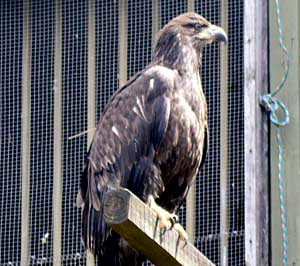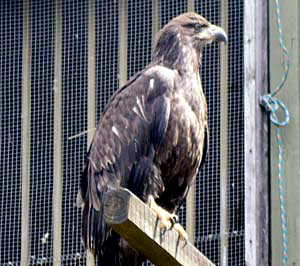[/av_textblock] [av_textblock size=” font_color=” color=” custom_class=”] Citizen Tribune Online
Posted Saturday, August 3, 2013
By Chris Phipps, Tribune Staff Writer
One of the most majestic symbols of the United States is slowly recovering in a remote location on Douglas Lake.
The American Eagle is slowly being repopulated after years of decline thanks to the American Eagle Foundation, which Friday released two young birds into the wild at their hack tower location in Dandridge.
AEF Wildlife Coordinator Laura Sterbens said the foundation uses domestic breeding pairs of eagles and raises their young so they can be released into the wild in an effort to hopefully repopulate the species.
Sterbens said the parents are non-releasable eagles, so in order for the babies to be able to go into the wild, the foundation works hard to camouflage themselves and feed the eagles without being observed. This way, the babies think they are getting food from their parents.
The specific eagles that were being prepared for release were extra special because their birth was videotaped on a live feed outside of Dollywood and gained several followers, Sterbens said.
Those followers who call themselves “chatters,” because they discuss the birds of prey in an online chat group, have come together from all different parts of the U.S. including as far away as Arizona and Michigan. They came to Dandridge Friday to meet one another and watch the birds be released into the wild.
Debi Chernisky who made the trip from O’Fallon, Mo. said only 50 percent of eaglettes survive their first year of life, so what the foundation does is extremely important to the species’ survival.
Sterbens, who is the daughter of Foundation Founder and President Al Louis Cecere said the first year of life is the toughest, which is why the foundation closely monitors the birds.
The release is the first time the birds will have ever attempted flight. Whether the eagles leave immediately to try and fly is up to them. Some fly out immediately, some take as long as three days.
The release was also the first time that the foundation will use satellites to track the eagles by GPS transmitters so they will know where they end up.
The eagles were previously tracked by radio signals and had a limited traceable radius.
Each time the foundation releases an eagle, they do so in honor of a veteran or a fallen soldier.
For this particular release the foundation honored Sevier County resident Worth Miller.
Miller, a North Carolina native, was a prisoner of war for 15 months in Italy during World War II under Hitler’s Nazi regime.
Miller survived cruel treatment living off the equivalent of a slice of bread a week and eating grass for nourishment. When he was rescued he weighed only 77 pounds.
Miller got to name the male eagle, “Thunderbird,” after his company in the war.
The female eagle was named “Destiny” through a contest the foundation held.
During the ceremony the Marine Corp League Chapter 1202 presented a flag to Miller and the foundation also gave him a wall decoration to symbolize the release.
Miller said the honor was more than he could put into words, and it was a unique opportunity.
Being able to give the birds their freedom brought back a lot of memories of the day when he received his in the war.
Miller and two “chatters” got the honor of pulling the rope to open the eagles’ home.
One of the volunteers with the foundation said the Thunderbird and Destiny were calmer than some other eaglettes so they anticipated the two wouldn’t be antsy to fly for the first time.
As soon as the cage was opened both steeped out to take a look, Thunderbird perched himself on a limb right outside the cage. After about 10 minutes, he as most males do, decided to test his new freedom first.
The bird flapped his wings and went regally soaring out past the lookout site. Unfortunately his first flight didn’t last long as he landed in the lake. The foundation, which is prepared such an occurrence, had a boat on stand-by to rescue the young bird.
After Thunderbird was found and brought back to the site with soggy feathers, he was placed in the nearby forest to dry off his wings before trying for freedom once again.
Thunderbird’s sibling, Destiny, was a lot more timid after her brother’s flight.
She preferred to put on a show, waving her brown feathers in the air and jumping from the perches of the hack tower.
Sterbens said the eagles will leave on their time, and the foundation will not force them to fly.
The eagles can be tracked and watched by visiting www.eagles.org/TrackingEagles/
###
[/av_textblock]


